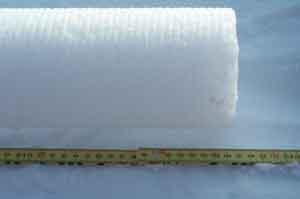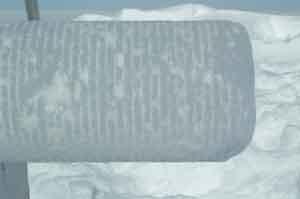12 May, 2003
Weather: Most clear skies with a little ice fog hanging around. Very cold and windy, temps in the morning were near –40 and wind chills downright scary! Looks to improve!
Camp Life:
At this time camp life is directly related to the weather. The hot water bottle in the sleeping bag did some good last night but wasn’t doing much this morning. The frost around the opening of my sleeping bag had built up enough that it looked like a big beard. Each morning we melt snow and have hot chocolate or tea followed by granola and dried fruit. Throughout the day we snack on ‘power’ like bars and drink plenty of fluids. The main meals or either soups or dehydrated foods such as Kung Fu Chicken, spaghetti, brown rice and chicken and everyone’s favorite shrimp newberg.
Ice Cores
We are now at site 2 called D4. In two days of drilling we have successfully pulled up about 70m of core. As we continue to drill deeper the cores begin to change. To many of you snow and ice is just that, snow or ice. It is just another phase of water. We have all tried to make a snowman or snowball to throw at your favorite teacher only to realize that the snow does not stick. There are times when you have to shovel your driveway and the snow seems to weigh a ton. Just like the differences I explained, ice and snow in Greenland can be different. I am finding out that there are many different types of snow and ice and each has its own different properties. While we are drilling ice cores it is easy to see the differences as we move from the surface to 150m. At the top of the ice cap is firn. To most of us firn looks just like snow but maybe a little more compacted. Once more snow is accumulated over the top of the snow it gradually becomes denser and begins to look like ice. The first layers of ice have many air bubbles and as you go deeper the ice has fewer air bubbles looks solid. The area between the firn and the solid ice is called the transitions zone. Once the ice is compacted without an air bubbles the density of the ice will no longer change. It is as smashed as it can be. We are only drilling to 150m, however many scientists who drill deep cores below 500m will find that the ice begins to warm up and is in a liquid form near the surface of the underlying land. This melting is caused by plate tectonics and the heating of the Earths crust and mantle. Look at the following images and figure out the differences in snow and ice in regards to density of the snow and ice.
Density Example:
_________
To find the volume of the core:
The volume of the core can be visualized as a two part process:
1) Find the area of the top of the disc of the core (pr2)
2) Multiply the area of the disc by the length of the core.
In math terms, it is written: pr2L,
Where p = 3.14
r = radius (radius is half of the diameter)
L = length of core
Example: Suppose we have an ice core with the following measurements
100cm long 10.0 cm diameter 6200 grams
1) The area of the top disc is: pr2
3.14 (pie) times the radius squared (5 x 5 = 25).
3.14 x 25 = 78.5 cm squared.
2) To get volume
78.5 cm2 times 100 cm2 equals 7850 cm cubed
Finally,
To get density divide mass by volume. 6200 grams divided by 7850 cm cubed
D = mass/volume
= 6200 grams / 7850 cm cubed
= 0.790 grams/cm cubed
Now find the densities of the following ice cores:
5m deep 112 cm long 9.7 cm diameter 5000 grams
20m deep 106 cm long 10.1 cm diameter 5207 grams
50m deep 98.5 cm long 10.27 cm diameter 6090 grams
90m deep 91.5 cm long 10.3 cm diameter 6799grams
130m deep 89 cm long 10.3 cm diameter 6712 grams
150m deep 97.5 cm long 10.27 cm diameter 6953 grams
How does density change as you go deeper beneath the surface?

This is an image of a core taken 6m below the surface. Compare it to the core taken at 150m.

Core from 150m below the surface.
Contact the TEA in the field at
.
If you cannot connect through your browser, copy the
TEA's e-mail address in the "To:" line of
your favorite e-mail package.
|
